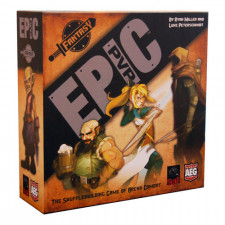Epic PvP: Fantasy Review
on Apr 19, 2016
Card-based dueling is as old as cards themselves, and Epic PvP: Fantasy, successfully Kickstarted in 2015 by Alderac Entertainment Group, adds its own twist to the genre by including a variant of deck construction and a nod to the mana system introduced by Magic: the Gathering to create a fast-paced fighting game with unique warrior combinations and multiple uses for the cards in a player’s hand that results in a game that’s almost too tactical to be just labeled a filler. Almost.
The main game mode pits two players in a duel to the death involving cards and the occasional token, and the way players build their warrior is perhaps the game’s most unique feature. Choosing, or randomly allocating, one of the four races and four classes to each player results in a deck of cards made from each race and class. One duel may involve a Goblin Ranger fighting a Dwarf Rogue, while the next battle pits that same Goblin, now a Druid, against a Dwarven Paladin.
Once players shuffle their two partial decks together, they set aside a number of cards equal to their gladiator’s life total, listed on the race card, and deal themselves five cards from their deck. Alternating turns, the active player first draws two cards and lays them face-down in front of their warrior’s board, made up of their race and class boards set together Small World style. This forms their aggression pile, with its quantity determining the cost a player can pay to play move cards from their hand. Each move card is both attack and block, having values in each on its face, in addition to its cost, and players lay them down initially as blocks, lining them up with their opponent’s attack, if the number equals or exceeds the attack value. After the attack is blocked, the attacker’s cards are removed, the defender’s cards are rotated to become attacks, and the other player takes their turn. Any unblocked attacks force the defender to discard a card from their life pile, and if a player has no life cards left, they lose. Some cards are skills, which have no aggression cost, but can only be put into play at certain times, conveying either one-time or permanent benefits to the player.
This back and forth, attack and defend gameplay is common to dueling games, but Epic PvP adds two wrinkles to it. The first is the aforementioned rotating cards, but the second, and bigger, novelty is the multiple uses for players’ decks. Cards can be either moves, aggression or life, and duelers are forced to choose, thanks in large part to cards only being drawn from their decks to add to their aggression pile. If a player needs more cards in hand, they must declare, without first looking at them, how many cards they’re drawing from their aggression pile, balancing the need for more attack options with the resources needed to play them. It’s a clever way to make varied use of a single game component.
Card utility aside, the mixing of different racial and class abilities is the main draw of the game, allowing for varying tactics, increased replayability and sixteen different warrior combinations without any of the expansion sets. Epic PvP’s goal is to create exclusive fighters by blending races and classes, allowing a high elf ranger to be different from a high elf rogue, which is an audacious plan for a game with such a relatively small number of components, and the unique ability on each race and class board lend themselves to the plan’s fruition, as well as the unique skill and attack cards in each deck. These specific elements can separate the combinations from one another, and they’d create truly distinctive matchups if there were just a bit more of them.
Players create a forty-card deck, evenly split between class and race, but less than half of those cards are unique to the fighter’s origin, and roughly ten percent of them are skills. This relative commonality can ensure a smooth contest and an even playing field, which are both a benefit to gameplay parity and a dent in the notion of disparate archetypes. Depending on card draw, a Human Paladin can fight exactly like a Dwarf Rogue, breaking the fantasy the game title alludes to, and perhaps revealing the challenge of creating a Magic-like variety without asking players to sign up to a lifetime of booster buying.
Epic PvP: Fantasy can also be played as a three-person free for all or in teams of two, primarily because the base card set allows it and the rules are adaptable, but it feels like what its designers probably felt it to be when they added it: an add-on, and not the true purpose of the game. Epic PvP accomplishes its true purpose fairly well, delivering a fast, tactical experience that’s easy to learn and challenging to master, and when the decks’ race- or class-specific cards come into play, the illusion of a unique warrior comes into play as well, delivering big entertainment in a small package.

 Customer Support
Customer Support  Subscribe
Subscribe 




 Account
Account  Wishlist
Wishlist 

